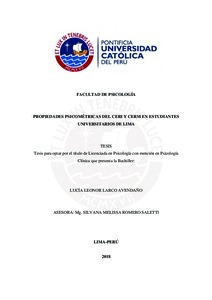| dc.contributor.advisor | Romero Saletti, Silvana Melissa | es_ES |
| dc.contributor.author | Larco Avendaño, Lucía Leonor | es_ES |
| dc.date.accessioned | 2018-12-17T22:44:42Z | es_ES |
| dc.date.available | 2018-12-17T22:44:42Z | es_ES |
| dc.date.created | 2018 | es_ES |
| dc.date.issued | 2018-12-17 | es_ES |
| dc.identifier.uri | http://hdl.handle.net/20.500.12404/13161 | |
| dc.description.abstract | La investigación analiza las propiedades psicométricas del Cuestionario de Experiencias
Relacionadas al Internet (CERI) y del Cuestionario de Experiencias Relacionadas al
Móvil (CERM) en 508 estudiantes de una universidad privada de Lima. Se aplicó la
Escala de Adicción a Internet de Lima (EAIL), la Escala de Zung para la depresión (SDS),
el Inventario de Ansiedad Rasgo-Estado (IDARE) y la Escala de Alexitimia de Toronto
(TAS-20) para la validez convergente y discriminante. Para validez de criterio se hicieron
comparaciones con las horas de uso de internet y celulares.
Para el CERI, se obtuvo una estructura bifactorial con un 33.47% de varianza explicada.
La confiabilidad mostró una consistencia interna adecuada para la prueba, siendo de .73,
y cuestionable para las áreas siendo de .69 y .62. En el CERM, se obtuvo una estructura
unifactorial con un 37.76% de varianza explicada. La confiabilidad mostró una
consistencia interna adecuada, siendo de .81. Las relaciones del CERI y CERM con el
EAIL resultaron significativas, directas y grandes; con el SDS, IDARE y TAS-20
resultaron significativas, directas y medianas. La comparación del CERI y sus dos áreas
con las horas de conexión a internet fue significativa y pequeña para el CERI y su primera
área. La comparación del CERM con las horas de conexión al celular fue significativa y
pequeña. Con ello, el CERI no evidencia contar con propiedades psicométricas adecuadas
para medir el uso problemático de internet, pero se confirma que el CERM cuenta con
propiedades psicométricas adecuadas para evaluar el uso problemático del celular. | es_ES |
| dc.description.abstract | The study focuses on the psychometric properties of the Internet Experiences
Questionnaire (CERI) and the Cell pone Experiences Questionnaire (CERM) in 508
students of a private college in Lima. The instruments to determine convergent and
discriminant validity of the scales were the Internet addiction scale of Lima (EAIL), The
Zung Self-Rating Depression Scale (SDS), The State-Trait Anxiety Inventory (STAI),
and the Toronto Alexithymia Scale (TAS-20). For evidence of criterion validity,
comparisons were made with the daily hours of Internet and cell phone use.
Results from the factorial analysis of CERI reveal a two dimensional structure with a
33.47% of explained variation. In addition, the reliability analysis shows a suitable
internal consistency of .73 for the total score of the scale, and questionable for the areas
with values of .69 and .62. The results from the factorial analysis of CERM reveal one
dimensional structure with a 37.76% of explained variation. The reliability analysis
shows a suitable internal consistency of .81. Significant, direct and large correlations of
CERI and CERM with EAIL and significant, direct and medium correlations of CERI
and CERM with SDS, STAI and TAS-20. The comparison of CERI, its two areas and
CERM with the hours of Internet connection and cell phone use was significant and small
for CERI, its first área and CERM. With this, CERI can’t show that has adequate
psychometric properties the measure the Internet problematic use, but it is confirmed that
CERM is an instrument with adequate psychometric properties to evaluate cell phone’s
problematic use. | es_ES |
| dc.language.iso | spa | es_ES |
| dc.publisher | Pontificia Universidad Católica del Perú | es_ES |
| dc.rights | info:eu-repo/semantics/openAccess | es_ES |
| dc.rights.uri | http://creativecommons.org/licenses/by/2.5/pe/ | * |
| dc.subject | Adicción a internet | es_ES |
| dc.subject | Teléfonos celulares | es_ES |
| dc.subject | Depresión mental | es_ES |
| dc.subject | Ansiedad (Psicología) | es_ES |
| dc.subject | Alexitimia | es_ES |
| dc.title | Propiedades psicométricas del CERI y CERM en estudiantes universitarios de Lima | es_ES |
| dc.type | info:eu-repo/semantics/bachelorThesis | es_ES |
| thesis.degree.name | Licenciado en Psicología con mención en Psicología Clínica | es_ES |
| thesis.degree.level | Título Profesional | es_ES |
| thesis.degree.grantor | Pontificia Universidad Católica del Perú. Facultad de Psicología | es_ES |
| thesis.degree.discipline | Psicología con mención en Psicología Clínica | es_ES |
| renati.discipline | 313026 | es_ES |
| renati.level | https://purl.org/pe-repo/renati/level#tituloProfesional | es_ES |
| renati.type | http://purl.org/pe-repo/renati/type#tesis | es_ES |
| dc.publisher.country | PE | es_ES |
| dc.subject.ocde | https://purl.org/pe-repo/ocde/ford#5.01.00 | es_ES |






